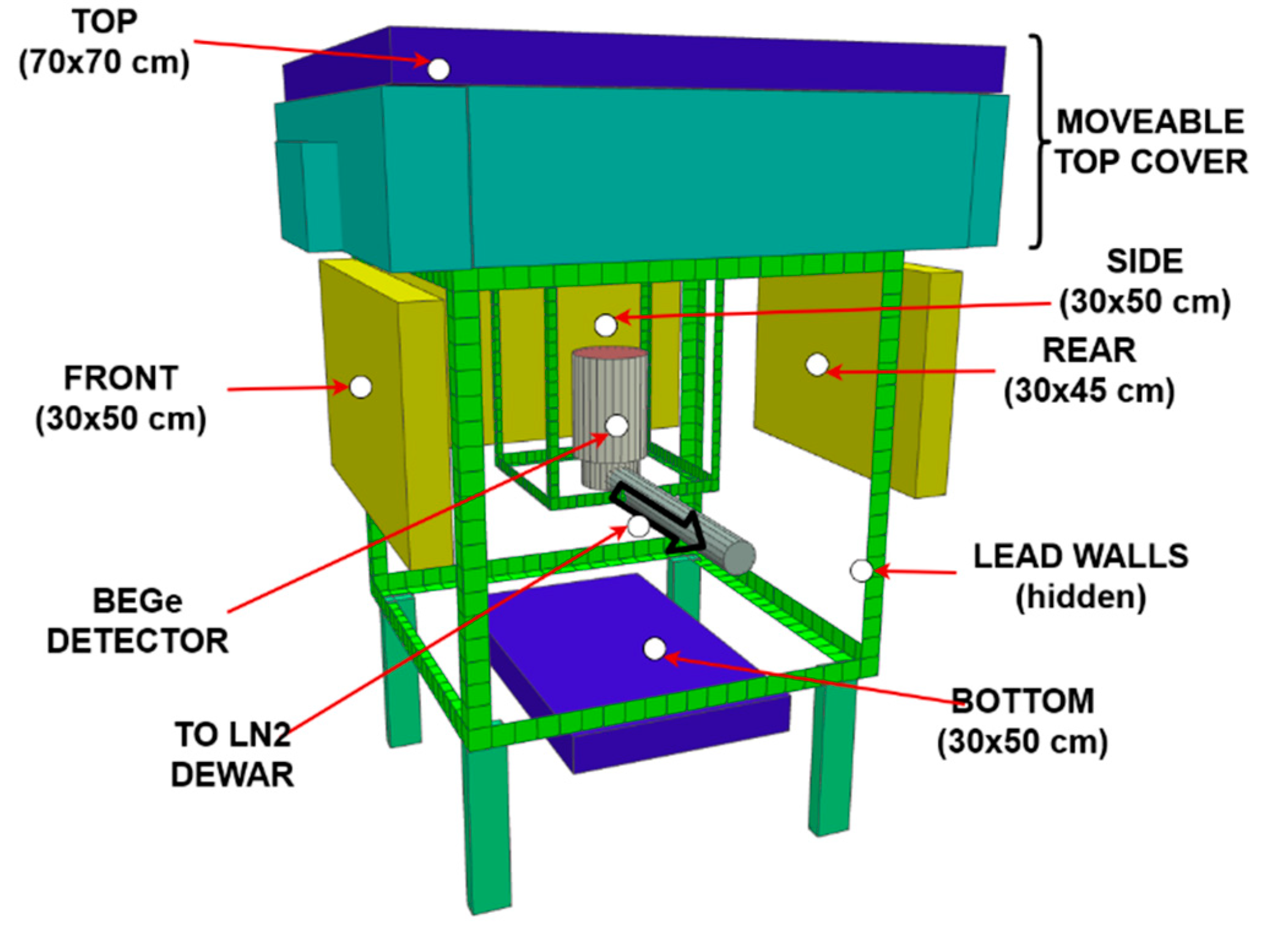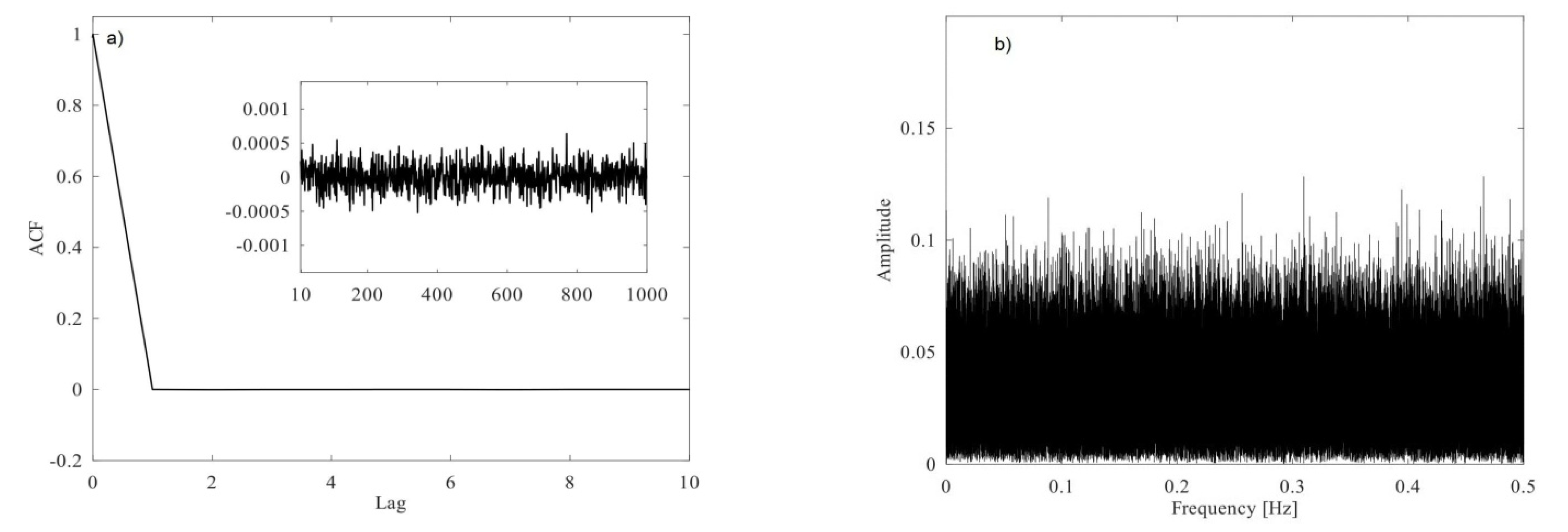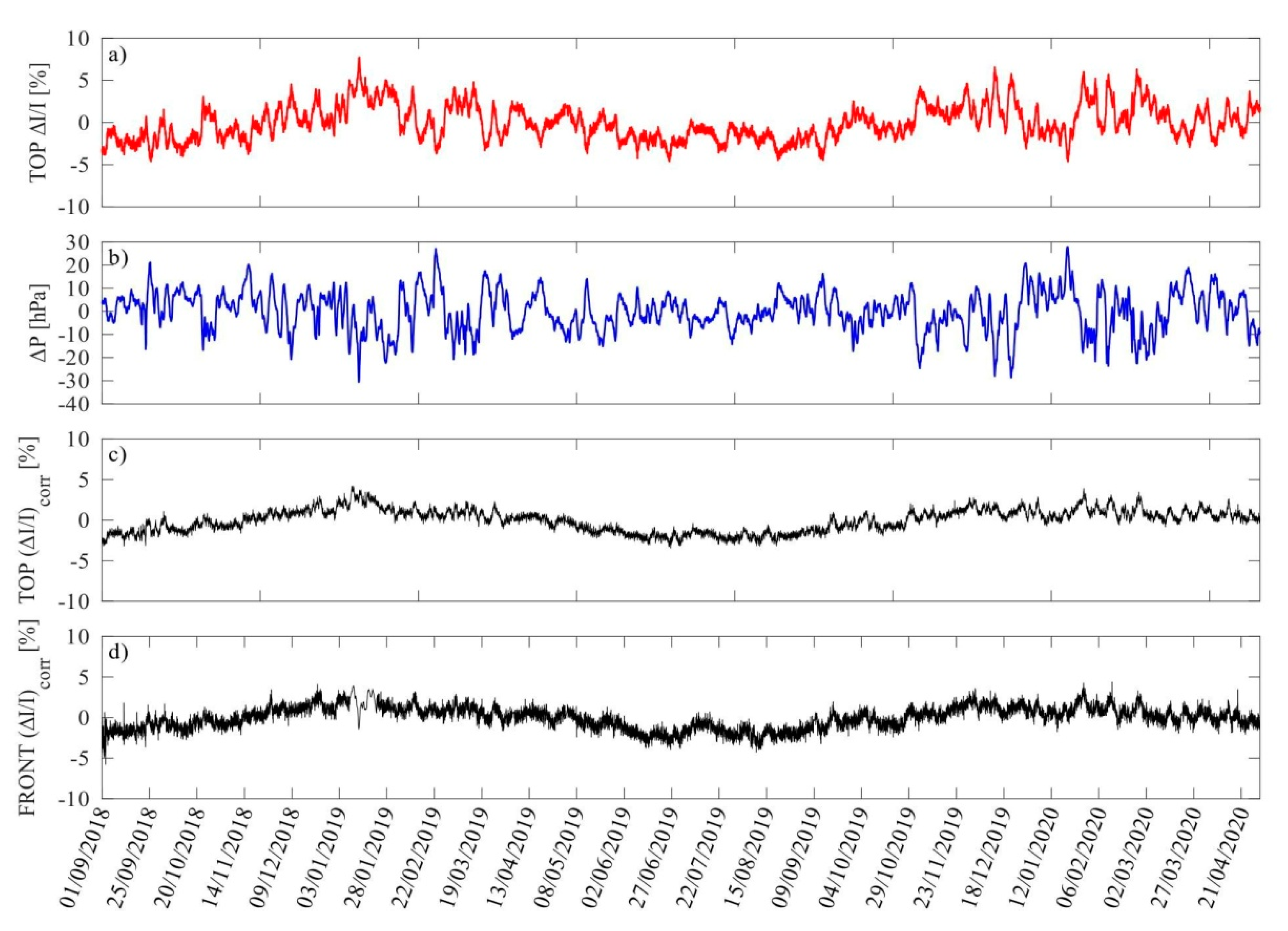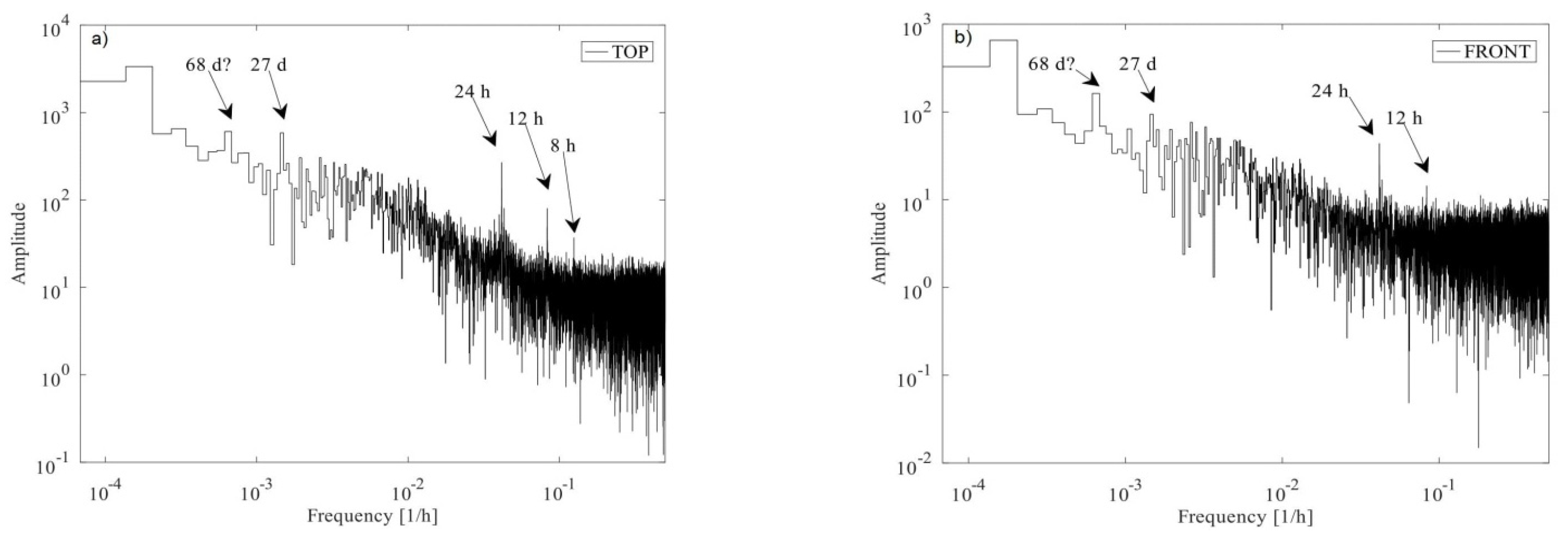Investigations of Muon Flux Variations Detected Using Veto Detectors of the Digital Gamma-rays Spectrometer
Abstract
:1. Introduction
2. Materials and Methods
- Absorption having a negative impact on the intensity of the muon flux. With increasing atmospheric pressure (and thus the amount of matter in the air column), the probability of absorption and scattering of particles is increased;
- Decay also demonstrating the negative effect, including the increase in the number of muons decays with increasing atmospheric pressure, which is caused by the increase in the height at which muons are generated;
- Generation defines the positive impact on the muon flux intensity and considers the increase in the number of pions produced with increasing pressure.
3. Results and Discussion
3.1. Short Period Data
3.2. Long-Period Data
4. Conclusions
Author Contributions
Funding
Institutional Review Board Statement
Informed Consent Statement
Data Availability Statement
Acknowledgments
Conflicts of Interest
References
- Gorzkiewicz, K.; Mietelski, J.W.; Kierepko, R.; Brudecki, K. Low-background, digital gamma-ray spectrometer with BEGe detector and active shield: Commissioning, optimisation and software development. J. Radioanal. Nucl. Chem. 2019, 322, 1311–1321. [Google Scholar] [CrossRef] [Green Version]
- Wen, X.; Zhou, F.; Fukuwa, N.; Zhu, H. A simplified method for impedance and foundation input motion of a foundation supported by pile groups and its application. Comput. Geotech. 2015, 69, 301–319. [Google Scholar] [CrossRef]
- Gilmore, G.; Hemingway, J.D. Practical Gamma-ray Spectrometry; Wiley: Chichester, UK, 1995. [Google Scholar]
- Núñez-Lagos, R.; Virto, A. Shielding and background reduction. Appl. Radiat. Isot. 1996, 47, 1011–1021. [Google Scholar] [CrossRef]
- Griender, P.K.F. Cosmic Rays at Earth: Researcher’s Reference Manual and Data Book, 1st ed.; Elsevier Science B.V.: Amsterdam, The Netherlands, 2001; ISBN 0444507108. [Google Scholar]
- Cecchini, S.; Spurio, M. Atmospheric muons: Experimental aspects. Geosci. Instrum. Methods Data Syst. 2012, 1, 185–196. [Google Scholar] [CrossRef] [Green Version]
- Jovančević, N.; Krmar, M.; Mrda, D.; Slivka, J.; Bikit, I. Neutron induced background gamma activity in low-level Ge-spectroscopy systems. Nucl. Instrum. Methods Phys. Res. Sect. A Accel. Spectrom. Detect. Assoc. Equip. 2010, 612, 303–308. [Google Scholar] [CrossRef]
- Kudryavtsev, V.A.; Spooner, N.J.C.; McMillan, J.E. Simulations of muon-induced neutron flux at large depths underground. Nucl. Instrum. Methods Phys. Res. Sect. A Accel. Spectrom. Detect. Assoc. Equip. 2003, 505, 688–698. [Google Scholar] [CrossRef] [Green Version]
- Savic, M.; Dragic, A.; Veselinovic, N.; Udovicic, V.; Banjanac, R.; Jokovic, D.; Maletic, D. Effect of pressure and temperature corrections on muon flux variability at ground level and underground. arXiv 2016, arXiv:1701.00164. [Google Scholar]
- Maghrabi, A.; Almutayri, M. Atmospheric Effect on Cosmic Ray Muons at High Cut-Off Rigidity Station. Adv. Astron. 2016, 2016, 1–9. [Google Scholar] [CrossRef]
- Dorman, L.I. Cosmic Rays in the Earth’s Atmosphere and Underground. 2004. Available online: https://link.springer.com/book/10.1007/978-1-4020-2113-8?page=1#toc (accessed on 24 August 2021). [CrossRef]
- Dayananda, M.A. Correlation Studies of Cosmic Ray Flux and Atmospheric and Space Weather. Ph.D. Thesis, Georgia State University, Atlanta, GA, USA, 2013. [Google Scholar]
- De Mendonça, R.R.S.; Raulin, J.-P.; Echer, E.; Makhmutov, V.; Fernandez, G. Analysis of atmospheric pressure and temperature effects on cosmic ray measurements. J. Geophys. Res. Space Phys. 2013, 118, 1403–1409. [Google Scholar] [CrossRef]
- Savić, M.; Maletic, D.; Joković, D.; Veselinović, N.; Banjanac, R.; Udovičić, V.; Dragic, A. Pressure and temperature effect corrections of atmospheric muon data in the Belgrade cosmic-ray station. J. Phys. Conf. Ser. 2015, 632. [Google Scholar] [CrossRef]
- Ross, S.M. Introduction to Probability Models, 10th ed.; 2010; ISBN 978-0-12-375686-2. Available online: http://fac.ksu.edu.sa/sites/default/files/book_solution.pdf (accessed on 24 August 2021).
- Homola, P.; Beznosko, D.; Bhatta, G.; Bibrzycki, Ł.; Borczyńska, M.; Bratek, Ł.; Budnev, N.; Burakowski, D.; Alvarez-Castillo, D.E.; Almeida Cheminant, K.; et al. Cosmic-Ray Extremely Distributed Observatory. Symmetry 2020, 12, 1835. [Google Scholar] [CrossRef]
- International Q-Days and D-Days. Available online: http://wdc.kugi.kyoto-u.ac.jp/qddays/ (accessed on 14 February 2021).
- Kudela, K.; Langer, R. On quasi-periodic variations of low-energy cosmic rays observed near earth. Radiat. Prot. Dosim. 2015, 164, 471–476. [Google Scholar] [CrossRef] [PubMed]
- Arunbabu, K.P.; Ahmad, S.; Chandra, A.; Gupta, S.K.; Dugad, S.R.; Hariharan, B.; Hayashi, Y.; Jagadeesan, P.; Jain, A.; Jhansi, V.B.; et al. Atmospheric temperature dependence of muon intensity measured by the GRAPES-3 experiment. In Proceedings of the 35th International Cosmic Ray Conference—ICRC2017, Busan, Korea, 12–20 July 2017. [Google Scholar]
- Modzelewska, R.; Alania, M. Dependence of the 27-day variation of cosmic rays on the global magnetic field of the Sun. Adv. Space Res. 2012, 50, 716–724. [Google Scholar] [CrossRef] [Green Version]
- Takai, H.; Feldman, C.; Minelli, M.; Sundermier, J.; Winters, G.; Russ, M.K.; Dodaro, J.; Varshney, A.; McIlwaine, C.J.; Tomaszewski, T.; et al. Tidal Frequencies in the Time Series Measurements of Atmospheric Muon Flux from Cosmic Rays. arXiv 2016, arXiv:1610.05983. [Google Scholar]
- Kovalyov, M.; Kovalyov, S. On the relationship between cosmic rays, solar activity and powerful earthquakes. arXiv 2014, arXiv:1403.5728. [Google Scholar]








Publisher’s Note: MDPI stays neutral with regard to jurisdictional claims in published maps and institutional affiliations. |
© 2021 by the authors. Licensee MDPI, Basel, Switzerland. This article is an open access article distributed under the terms and conditions of the Creative Commons Attribution (CC BY) license (https://creativecommons.org/licenses/by/4.0/).
Share and Cite
Gorzkiewicz, K.; Mietelski, J.W.; Ustrnul, Z.; Homola, P.; Kierepko, R.; Nalichowska, E.; Brudecki, K. Investigations of Muon Flux Variations Detected Using Veto Detectors of the Digital Gamma-rays Spectrometer. Appl. Sci. 2021, 11, 7916. https://doi.org/10.3390/app11177916
Gorzkiewicz K, Mietelski JW, Ustrnul Z, Homola P, Kierepko R, Nalichowska E, Brudecki K. Investigations of Muon Flux Variations Detected Using Veto Detectors of the Digital Gamma-rays Spectrometer. Applied Sciences. 2021; 11(17):7916. https://doi.org/10.3390/app11177916
Chicago/Turabian StyleGorzkiewicz, Krzysztof, Jerzy W. Mietelski, Zbigniew Ustrnul, Piotr Homola, Renata Kierepko, Ewa Nalichowska, and Kamil Brudecki. 2021. "Investigations of Muon Flux Variations Detected Using Veto Detectors of the Digital Gamma-rays Spectrometer" Applied Sciences 11, no. 17: 7916. https://doi.org/10.3390/app11177916
APA StyleGorzkiewicz, K., Mietelski, J. W., Ustrnul, Z., Homola, P., Kierepko, R., Nalichowska, E., & Brudecki, K. (2021). Investigations of Muon Flux Variations Detected Using Veto Detectors of the Digital Gamma-rays Spectrometer. Applied Sciences, 11(17), 7916. https://doi.org/10.3390/app11177916







